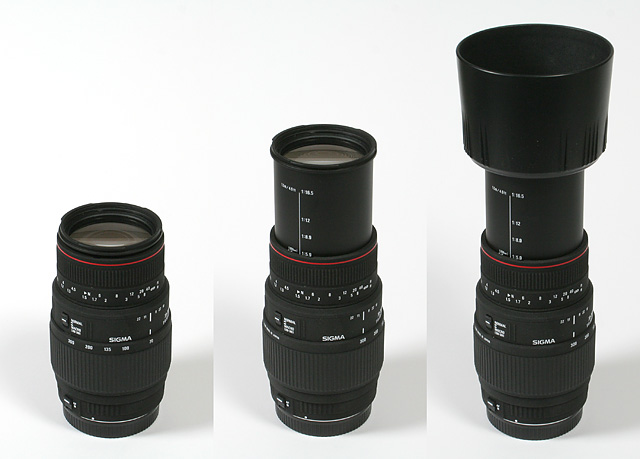|
Sigma AF 70-300mm f/4-5.6 DG APO macro - Review / Test Report |
|
Lens Reviews -
Canon EOS (APS-C)
|
|
Page 1 of 3
Review by Klaus Schroiff, published November 2005
Special thanks to Frank Kirchner for providing this lens!
Introduction
Throughout modern times the Sigma 70/75-300mm APO variants were always positioned
as a supposedly superior alternative to the base offerings of the genuine manufacturers
in this lens group. The latest incarnation is the Sigma AF 70-300mm f/4-5.6 DG APO macro.
Sigma claims to have used an APOchromatic design for the lens which is
surely a little optimistic but they've incorporated some special elements into it
to stand out from the rest of the crowd. The DG (Digital) designation
refers to an improved coating optimized for digital sensors but naturally the
lens remains still usable on film SLRs. On APS-C DSLRs such as the
Canon EOS 350D (used for testing) the field-of-view of the lens is equivalent
to 112-480mm on full frame cameras. This is sufficient for many aspects of tele
photography though the rather small max. aperture isn´t overly suitable for
small depth-of-field applications such as portraits.

The optical design of the lens is made of 14 elements in 10 groups including 2
SLD (Special Low Dispersion) elements.
It´s a fairly compact lens with a min. size of 77x122mm and a weight of 550g.
The aperture mechanism features 9 blades for an improved bokeh which is fairly
impressive for a budget lens. The min. focus distance is 150m resulting in
a max. magnification of 1:4.1 at 300mm but there´s also a dedicated macro mode
(via a switch, limited to 200-300mm) which provides a magnification of 1:2.9 to 1:2.
Due to the lack of floating elements in the focusing group you shouldn´t
expect the performance of a true macro lens though. The filter size is 58mm.
Mechanically the lens remains in line with the typical limitations
of this lens group. The lens extends during zooming and the front element
rotates during focusing which makes using a polarizer difficult at best.
The zoom mechanism is a little on the stiff side whereas the focusing
ring operates pretty smooth. The crinkle finish of the lens is similar to
Sigma EX used in their pro grade lenses - quite nice actually.
The package also sports a barrel-shaped lens hood as well as a soft-bag.
|